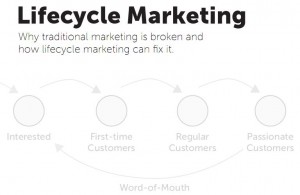 Leverage lifecycle Ecommerce marketing to build a consistent and engaging customer experience to be a true winner in the eCommerce gold rush. Businesses whom fail to provide a great customer experience while listening and engaging with their customers will never develop passionate, vocal and lifelong customers. Consumers are attracted to and passionate about brands that they love and enjoy. Take note of these three lifecycle marketing tactics to ensure your eCommerce efforts are growing passionate customers.
Leverage lifecycle Ecommerce marketing to build a consistent and engaging customer experience to be a true winner in the eCommerce gold rush. Businesses whom fail to provide a great customer experience while listening and engaging with their customers will never develop passionate, vocal and lifelong customers. Consumers are attracted to and passionate about brands that they love and enjoy. Take note of these three lifecycle marketing tactics to ensure your eCommerce efforts are growing passionate customers.1. Focus on the entire customer experience
The first touch a customer may have with your store may not even be your website. Maybe someone tweeted that they bought something from your store and a potential customer went to your twitter page to check you out. Or maybe someone posted a picture of what they bought from you on Facebook and then your potential customer went to your Facebook Page to check you out. It is important to be aware of and optimize for the entire customer experience. Below are examples of common touch points to optimize for:
- Social Media pages
- Website Homepage
- Website Social pages
- Product Pages
- About Pages / Terms and Conditions
- Shopping Cart
- Purchase Page
- Online Receipt
- Confirmation of Purchase Page
- Follow Up email for purchase
- Packaging of products
- Printed Receipt included in package
- Marketing collateral in package
- Follow up email after confirmation of delivery
There are other touch-points that will vary per business. Make sure you spend the time to map out the entire process and optimize a great customer experience all the way through. Watch this webinar on Consistent eCommerce Branding for Increased Customer Loyalty to learn from the customer experience experts over at Moosejaw.
2. Invest time and resources into connecting with customers on social media
It should be no surprise to you that your customers are online and on social networks. The explosion of social media over the past several years has been well documented, most recently by Michael Stelzner of Social Media Examiner with the 2011 Social Media Marketing Report. It is not enough to just have an account on Twitter and Facebook to be successful. You have to be engaged, active and actually care about the customers and prospects you communicate with. Don't look at your twitter followers or facebook fans as simple numbers. Treat these people as if they were actual shoppers in your store or excited customers visiting your shop in a large marketplace.
The best examples of successful social media channels generally have a dedicated resource or team of resources with essential tools to operate them properly. Ensure that your company has either a single dedicated resource (eg. Social Media Manager), an agency to help you get started or tools to help your existing teams better utilize social media (eg. HubSpot, SEOmoz, Raven Tools). The investment in positive customer and prospect social media experience will have a long lasting effect on your business.
3. Reward regular and passionate customers
Regular customers are those that have purchased at least once and returned to buy again. Passionate customers are advocates of your products and brand and will spread your praise to their networks through social media and word of mouth advertising. Social and word of mouth advertising should be one of your primary goals as a marketer. Passionate customers that turn vocal in praise is the absolute best (and cheapest) form of marketing imaginable. These customers should be very valuable to you, so reward them! Here are some ideas of how to reward and encourage passionate customers:
- Loyalty program
- Reward points program
- Feature customers in social media
- Fun contests
- Free stuff!






















